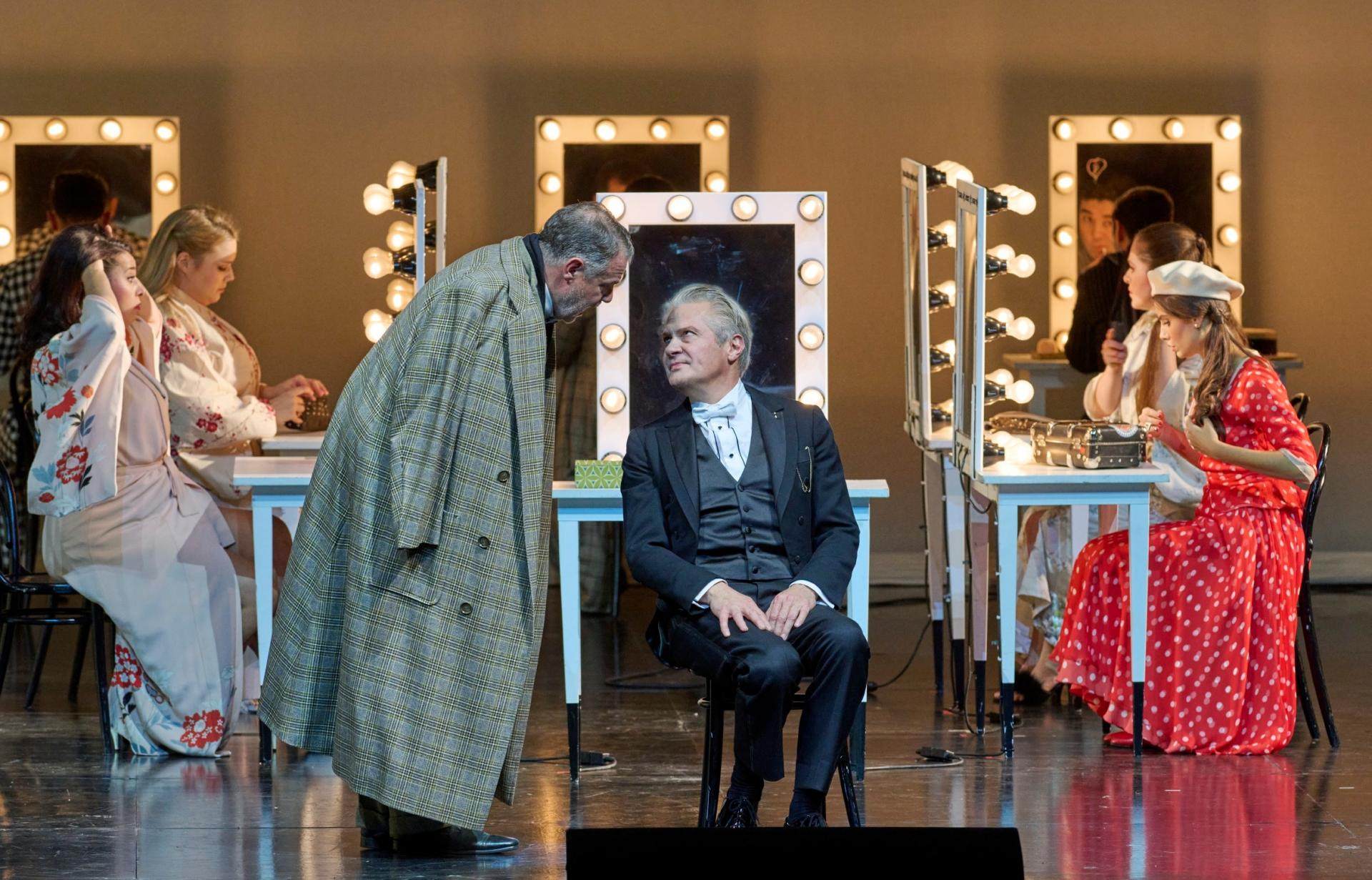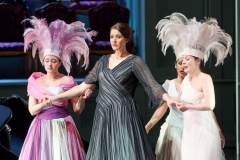Ariadne auf Naxos
February 2026 | ||||||
|---|---|---|---|---|---|---|
Mo | Tu | We | Th | Fr | Sa | Su |
Ariadne auf Naxos - Richard Strauss | Opera
Duration: approximately 3 hours
Text by Hugo von Hofmannsthal
PROLOGUE: 40 min
Intermission: 30 min
Opera: 85 min
SYNOPSIS
PROLOGUE
The servants of the richest man in Vienna are busy setting the stage for a planned performance in their master's palace. Behind the scenes, the two hired troupes are making their preparations:
One is to perform the first work of a young composer, the opera Ariadne auf Naxos, the other a dance masquerade in the Italian buffo style. Even the mutual jealousy between the members of the two troupes causes emotions to run high.
How much more so when the host, represented by his steward, announces an unexpected and unbelievable change to the program: At his request, the two stage plays are not to be presented to the invited guests one after the other, but simultaneously.
Deeply affected, the composer, who is concerned with the true realization of his artistic world view, wants to withdraw his creation and forgo his first public performance. But the practice-oriented music teacher and, above all, Zerbinetta, who is well versed in all the arts of seduction and knows how to trick the inexperienced young composer in no time at all, bring about a change of heart in him: with an emphatic hymn to the essence of music, the composer bows to reality and the instructions of his patron. The opera Ariadne auf Naxos is thus performed in the desired form, with interludes by an Italian comedy troupe.
OPERA
Ariadne is waiting to die in front of a cave on the shores of the island of Naxos, having been abandoned by Theseus, her lover.
and so she no longer hears or pays attention to anything around her: not to the three nymphs, not to the comedians who want to cheer her up, not even to Zerbinetta, who in a breakneck aria advises the mourners from her rich experience not to shed a tear for the departed and to be open to a new love.
A radiant youth approaches from afar, Bacchus, the god of eternal renewal. He comes from the arms of the sorceress Circe, with whom he could not find what he was looking for. Ariadne, mistaking him for the messenger of death, goes to meet him and, without immediately realizing it, immediately burns with ecstatic devotion, which is reciprocated by the god. Transformed by the other and as if newly created, Ariadne and Bacchus can conclude the opera as a just-too-mystically united couple.
Program and cast
The majordomo: Bernhard Schir
A music teacher: Jochen Schmeckenbecher
The composer: Samantha Hankey
The Tenor (Bacchus): Clay Hilley
Little Zerbinet: Erin Morley
The Primadonna (Ariadne): Anja Kampe
Harlequin: Stefan Astakhov
Musical direction: Cornelius Meister
Staging: Sven-Eric Bechtolf
stage: Rolf Glittenberg
Costumes: Marianne Glittenberg
Light: Jürgen Hoffmann
Vienna State Opera
Public Transport
Subway lines: U1, U2, U4
Trams: 1, 2, D, J, 62, 65
Buses: 59A
Local Railway: Badner Bahn
Stops: Karlsplatz / Opera
Taxi stands are available nearby.
Parking
Parking is only € 6, - for eight hours!
The Wiener Staatsoper and the ÖPARK Kärntner Ring Garage on Mahlerstraße 8, under the “Ringstraßengalerien”, offer the patrons of the Vienna State Opera a new, reduced parking fee. You can park in the Kärntner Ring Garage for up to 8 hours and pay only a flat fee of € 6, -. Just validate your ticket at one of the discount machines inside the Wiener Staatsoper. The normal rate will be charged for parking time greater than 8 hours. The validation machines can be found at the following coat checks: Operngasse, Herbert von Karajan-Platz, and the right and left and balcony galleries.
Important: In order to get the discount, please draw a ticket and do not use your credit card when entering the garage!
After devaluing your ticket in the Wiener Staatsoper you can pay comfortably by credit card or cash at the vending machines.
The machines accept coins and bills up to 50.- Euro. Parking time longer than 8 hours will be charged at the normal rate.
History
The structure of the opera house was planned by the Viennese architect August Sicard von Sicardsburg, while the inside was designed by interior decorator Eduard van der Nüll. It was also impacted by other major artists such as Moritz von Schwind, who painted the frescoes in the foyer, and the famous "Zauberflöten" (“Magic Flute”) series of frescoes on the veranda. Neither of the architects survived to see the opening of ‘their’ opera house: the sensitive van der Nüll committed suicide, and his friend Sicardsburg died of a stroke soon afterwards.
On May 25, 1869, the opera house solemnly opened with Mozart's Don Giovanni in the presence of Emperor Franz Joseph and Empress Elisabeth.
The popularity of the building grew under the artistic influence of the first directors: Franz von Dingelstedt, Johann Herbeck, Franz Jauner, and Wilhelm Jahn. The Vienna opera experienced its first high point under the direction of Gustav Mahler. He completely transformed the outdated performance system, increased the precision and timing of the performances, and also utilized the experience of other noteworthy artists, such as Alfred Roller, for the formation of new stage aesthetics.
The years 1938 to 1945 were a dark chapter in the history of the opera house. Under the Nazis, many members of the house were driven out, pursued, and killed, and many works were not allowed to be played.
On March 12, 1945, the opera house was devastated during a bombing, but on May 1, 1945, the “State Opera in the Volksoper” opened with a performance of Mozart's THE MARRIAGE OF FIGARO. On October 6, 1945, the hastily restored “Theaters an der Wien” reopened with Beethoven's FIDELIO. For the next ten years the Vienna State Opera operated in two venues while the true headquarters was being rebuilt at a great expense.
The Secretary of State for Public Works, Julius Raab, announced on May 24, 1945, that reconstruction of the Vienna State Opera would begin immediately. Only the main facade, the grand staircase, and the Schwind Foyer had been spared from the bombs. On November 5, 1955, the Vienna State Opera reopened with a new auditorium and modernized technology. Under the direction of Karl Böhm, Beethoven’s FIDELIO was brilliantly performed, and the opening ceremonies were broadcast by Austrian television. The whole world understood that life was beginning again for this country that had just regained its independence.
Today, the Vienna State Opera is considered one of the most important opera houses in the world; in particular, it is the house with the largest repertoire. It has been under the direction of Dominique Meyer since September 1, 2010.

 EN
EN DE
DE IT
IT FR
FR ES
ES RU
RU JP
JP RO
RO
 Seating plan
Seating plan 

